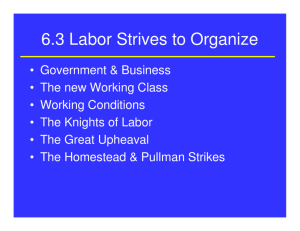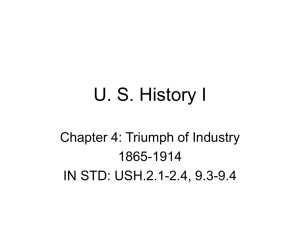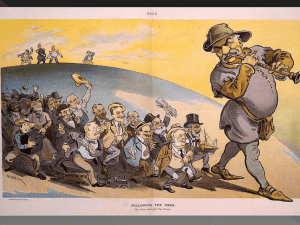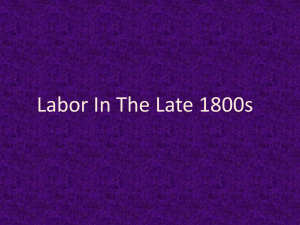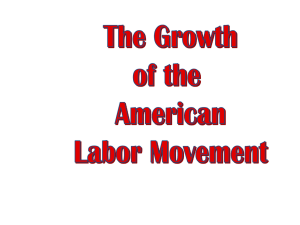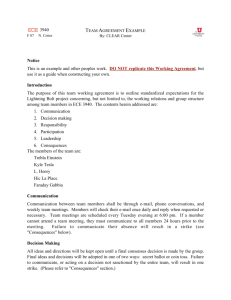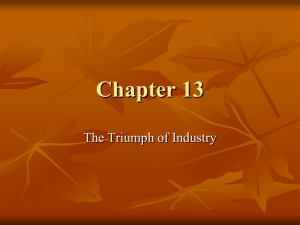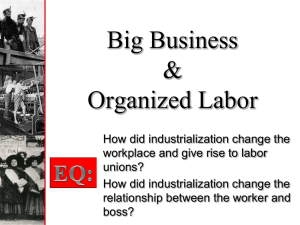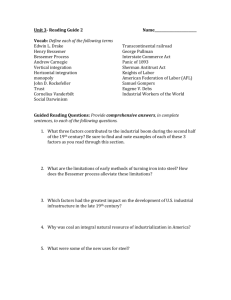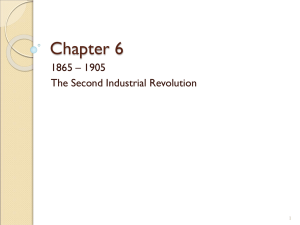Chapter 13 Triumph of Industry
advertisement
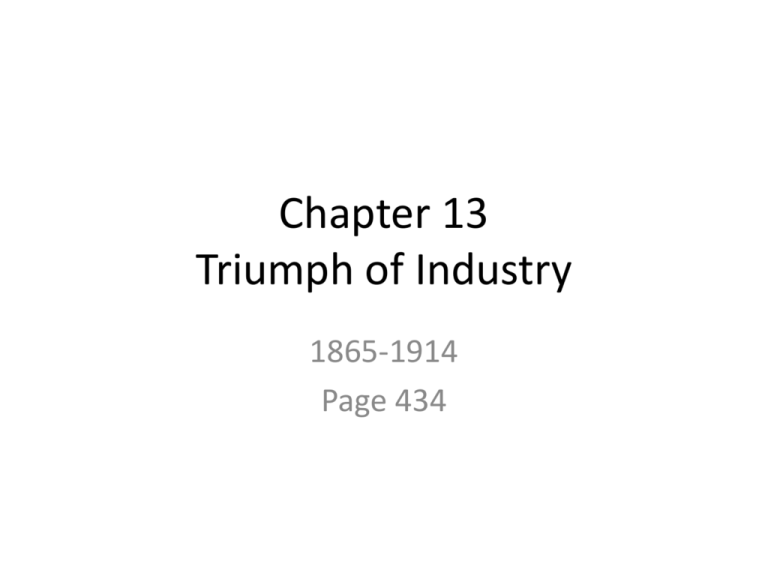
Chapter 13 Triumph of Industry 1865-1914 Page 434 Section 1 Technology and Industrial Growth • OBJ: Analyze Factors that led to Industrialization of the U.S. • Explain how inventions and innovations changed American lives • Describe the impact of industrialization in the late 1800’s A. Industrial Growth • Mass goods were needed during the Civil war • Fuels of industrial Growth: – Natural resources- coal, forests, rivers, oil- Edwin Drake and the first oil drill in Titusville Pen. – Growing workforce- immigration and people moving to cities – Capitalism- Horatio Alger and rags to riches stories • Entrepreneurs- trying to make money- fueled society with jobs and ideas – Government- Protective Tariffs and laissez-faire policies B. Innovations • Patent: _____________________ • Thomas Edison- applied for over a 1,000 patents • Perfected the light bulb • Designs for power plants to power cities • George Westinghouse- developed ways to transport energy over long distances. • Communication – Samuel Morse- invented telegraph and Morse code – Alexander Gram Bell- invented telephone • Steel – Bessemer Process- invented by Henry Bessemerbetter way to produce steel – Skyscrapers and suspension bridges now possible – Better railroads with steel – Brooklyn bridge- at time longest bridge in world1883 • Railroads – Trains expanded all over the country – TCR finished in 1869 – By 1883- 3 TCR’s – Led to development of time zones – New transportation allowed people to live farther from work • Electric rail cars, subways • 1903- first successful flight by Orville and Wilbur Wright • Spiral Growth – Industry increases industry??? – Example, more railroads means more production of railways, rail road cars. – More railroads means more goods transported, which means more consumers, which means more goods can be produced – GET IT – Leads to Mass Production C. Impact • • • • • • • • • • World Markets Linked Jobs becoming mechanized Jobs becoming unskilled More goods produced People move to cities Cities grow Immigration increases More jobs Environmental impact Peoples lives transformed Section 2 Rise of Big Business • Businesses now were corporations – Created by the gov’t to a group of people with the right to sell shares – Why would people buy shares? Dividends? • Advantage of Corporation – Raise capital – Limited liability – Not dependent on fate of owner Standard Oil • John D. Rockefeller got into oil business in 1862 • Wanted to simplify the production process • Gained control of all steps of Production • What is this called? • Put others out of business and created a monopoly U.S. Steel • Andrew Carnegie revolutionized the steel industry • Spent millions on steel research • Could produce steel cheaper than competition • Purchased or put out all competitors – What is this called • Created a monopoly and made billions • Donated millions towards the end of his life Government and Business • Should government play a role in business? • Laissez faire? – Government should “let people do what they choose” • Social Darwinism- survival of the fittestapplied to business. Best companies will survive • Use to justify bad business practices and great wealth Robber Barron vs. Captains of Industry • • • • • How should these business men be viewed Small businesses were squeezed out But jobs were provided Prices were lowered But monopolies led to less competition and higher prices. • What do you think?? Improvements by Gov’t • Morrill Act of 1862: – Gave each state federally land in order to establish institutes of higher education. IE UNL • Postal Reform was undertaken in 1860’s and on • Began to deliver right to houses • RFD started in 1896 • By 1913 mail was circulated throughout nation. Great for businesses • Cartels and Trusts – Cartel- several companies decided to limit competition among themselves and share the market. Result? – Trusts: Several companies controlled by one board. Result? Government Starts to Act • Interstate Commerce Commission – Wanted to make railroad rates fair – Gave gov’t power to regulate interstate commerce • Sherman Antitrust Act – Break up Monopolies • Were not enforced or were avoided Section 3 Organized Labor Movement • OBJ: Asses workers problems • Compare goals and strategies of different unions • Analyze cause and effects of different strikes A. Hardships for Workers • Wealth and higher standard of living for many because of I.R. • However, not for workers in factories • 12 hour days, 6 days a week, in dark, dirty, hot, and cramp factories. • Very dangerous- Sweat shops • If you got injured, you were fired • Low wages- demand set wages?? B. Labor Unions Form • Collective Bargaining: • Could lead to strikes • Some workers attracted to socialism- why? • Knights of Labor: included both skilled and unskilled labor • Focused on social reform and replacing capitalism with workers coops • Disappeared after failed strikes • American Federation of Labor: AFL: Samuel Gompers – Only allowed skilled workers – Focused on very specific work place reforms – Did not gain as much membership as Knights C. Haymarket Riot • • • • May 1 1886 in Chicago Knights went on strike at McCormic Company Peaceful 200 police summoned and after bomb exploded among them, they fired into the crowd • 11 were killed and over a hundred wounded • Gave bad name to strikes, brought end to KOL D. Homestead Strike • 1892 with the Carnegie Steel Company • Union contract coming to an end and Henry Frick, plant manager, saw a chance to break union • Cut wages • All workers decided to strike • Hired scabs and Pinkerton guards to protect the plant • 8,000 troops called in and strike put down E. The Pullman Strike • Built Pullman cars • George Pullman built actual town for his workers • 1893 laid off almost half of his workers and the rest received wage cuts • Workers went on strike • Pullman attached mail cars to all Pullman cars • U.S. gov’t put end to the strike, could not stop the mail F. Effects of Strikes • Courts and government often ruled against strikes • Was a time when gov’t usually sided with business owners over workers.
